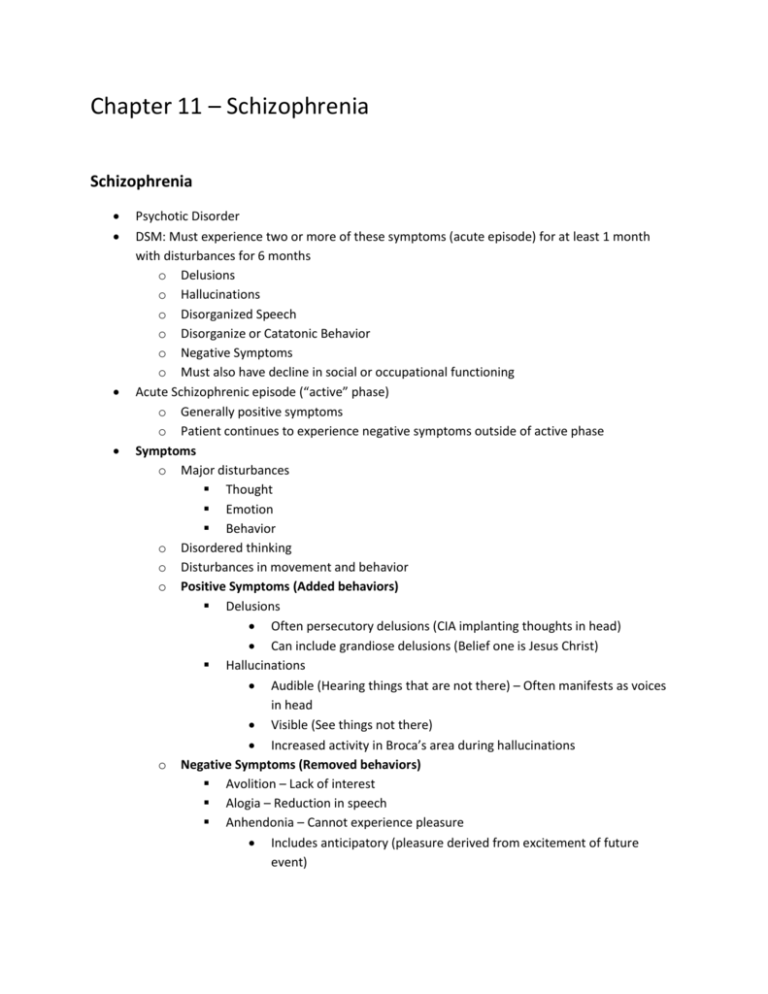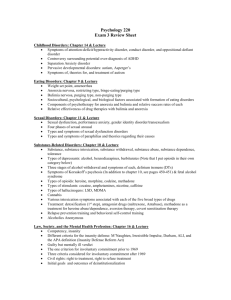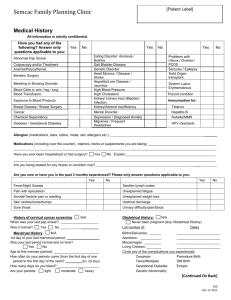Review Guide Final
advertisement

Chapter 11 – Schizophrenia Schizophrenia Psychotic Disorder DSM: Must experience two or more of these symptoms (acute episode) for at least 1 month with disturbances for 6 months o Delusions o Hallucinations o Disorganized Speech o Disorganize or Catatonic Behavior o Negative Symptoms o Must also have decline in social or occupational functioning Acute Schizophrenic episode (“active” phase) o Generally positive symptoms o Patient continues to experience negative symptoms outside of active phase Symptoms o Major disturbances Thought Emotion Behavior o Disordered thinking o Disturbances in movement and behavior o Positive Symptoms (Added behaviors) Delusions Often persecutory delusions (CIA implanting thoughts in head) Can include grandiose delusions (Belief one is Jesus Christ) Hallucinations Audible (Hearing things that are not there) – Often manifests as voices in head Visible (See things not there) Increased activity in Broca’s area during hallucinations o Negative Symptoms (Removed behaviors) Avolition – Lack of interest Alogia – Reduction in speech Anhendonia – Cannot experience pleasure Includes anticipatory (pleasure derived from excitement of future event) Includes consummatory (pleasure derived from participating in an activity) Flat Affect – Little emotion in face or voice Asociality – Unable to form personal relationships o Disorganized Symptoms Disorganized Speech Incoherence – Inability to organize and articulate ideas Loose associations – Goes off on tangents, difficulty in staying on one topic Disorganized Behavior Odd behavior o Silliness, easily agitated, strange clothing choices o Other Catatonia Motor abnormalities o Repetitive, complex gestures Generally of fingers and hands o Excitable, wild flailing of limbs Catatonic immobility o Maintain odd positions for long periods of time Waxy Flexibility o Other people can move and pose the person’s limbs Inappropriate affect Reacts emotionally to events opposite of social norms o i.e. laughing at a funeral Subtypes Disorganized – Disorganized/Flat Affect Catatonic – Prolonged immobility Paranoid – Delusions, hallucinations, ideas of reference (weatherman giving person signs) Undifferentiated – Meet criteria for schizophrenia, not for subtype Residual – No longer meets criteria but still shows signs of schizophrenia Poor predictive validity – much overlap among subtypes Other Psychotic Disorders o o o o Schizophreniform – Symptoms last greater than 1 month but last than 6 Brief Psychotic Disorder – Symptoms last 1 day to 1 month o Often triggered by extreme stress (i.e. death of a loved one) Schizoaffective Disorder – Symptoms of both mood disorder and schizophrenia Delusional Disorder – Have delusions but no other symptoms of schizophrenia Etiology of Schizophrenia o o o o o o Genetic o Not likely caused by single gene o Studies have been done but need to be replicated (some results inconsistent) o Genes identified – DTNGP1 and NGR1 Diathesis-Stress Model o May have heritable parts – though it is not known which parts DZ twin studies – 12% MZ twin studies – 44% Neurotransmitters o Dopamine Theory Disorder due to too much dopamine Drugs that reduce dopamine alleviate symptoms Help symptoms of schizophrenia Can cause similar symptoms to Parkinson’s Amphetamines increase dopamine – can cause psychosis Dopamine mainly related to positive symptoms Does not completely explain the disorder o Serotonin, GABA, and Glutamate also involved Brain Structure o Enlarged Ventricles Indicate loss of brain cells Connected to poor performance on cognitive tests o Reduced activity in Prefrontal Cortex Behaviors affected by schizophrenia are governed by prefrontal cortex (speech, decision making) o Congenital factors could be factors Reduced supply of oxygen during delivery Viral damage to fetal brain – Flu study (higher rates of schizophrenia in women who had flu in third trimester) Socioeconomic Status o Highest rates among urban poor Sociogenic Hypothesis (poverty first) Disorder caused by stress of poverty Social Selection Theory (disorder first) Disorder causes person to drift down in Socioeconomic Status Family Factors o Schizophrenogenic Mother Theory Cold, domineering mother causes child to develop schizophrenia o Family environment affects relapse Expressed Emotion – Hostility and over involvement in patient can lead to rehospitilization Treatment o o o o Effective treatment can differ based on stage of disease o I.e therapy may not be effective for a patient having an acute episode as they will be distracted Medication o 1st Generation – Thorazine Reduced agitation Lowered dopamine levels Little effect on negative symptoms Could cause tardive dyskinesia (develop tics) o Second Generation – Clozapine Fewer side effects Can cause a lowering of white blood cells Patient needs blood checked regularly Psychological o Medication plus psychosocial intervention Social skills training – learn how to get a job, bus schedule, etc. o Family Therapy Help reduce expressed emotion Educate family about Schizophrenia o CBT Recognize delusional thoughts Recognize and challenge negative behaviors Psychoanalytic o Freud did not really deal with Thought they could not be treated as they could develop a close bond with the therapist Chapter 13 – Gender and Identity Disorders Gender and Sex Cycle Views on human sexuality have changed over time o Victorian era, individuals wore high collars/ hid sexuality o Inhibition of sexuality is now considered to cause problems Men o Think more about sex, want more sex, have more partners o More dysfunction as they age Women o Desire sex based on relationship status and social norms o No more dysfunction found in older women than younger Sexual Response Cycle o Appetitive/Desire Phase Sexual interest or desire, often associated with fantasies o Excitement Phase Men and women experience pleasure and increase blood flow to the genitalia o Orgasm Phase Sexual pleasure peeks o Resolution Phase Relaxation and wellbeing, usually follow orgasm Sexual Desire Disorders Must be pervasive and lasting Hypoactive Sexual Disorder o Deficient or absent sexual fantasies or urges Low sex drive Can differ among cultures Sexual Aversion Disorder o Individual actively avoids genital contact with another person Sexual Arousal Disorders Female Sexual Arousal Disorder o Consistently inadequate vaginal lubrication that hinders sexual intercourse Male Erectile Disorder o Failure to maintain an erection during the course of sexual intercourse o Can often be physiological Orgasmic Disorders Female Orgasmic Disorder o Consistent absence of orgasm after sexual excitement Male Orgasmic Disorder o Consistent difficulty in ejaculating Premature Ejaculation o Ejaculation too quickly Sexual Pain Disorders Dyspareunia o Persistent or recurrent pain during sexual intercourse Vaginismus o Involuntary spasms of outer third of vagina that makes intercourse impossible Etiology of Sexual Dysfunctions Psychoanalytic o Repressed conflicts i.e. premature ejaculation is due to hostility against partner who reminds individual of his mother Masters and Johnson o Historical Causes Religious orthodoxy Sexual trauma Homosexual inclination o Current Causes Performance fears Spectator role Biological o Disease o Low hormone levels o Alcohol and tobacco Psychosocial o Rape o Early childhood sexual trauma o Relationship problems o Psychological disorders o Stress Treatment Anxiety Reduction Directed masturbation Change thought and attitudes Sexual skills training Communication training Couples therapy Medication and physical treatment o “squeeze” technique for premature ejaculation Masters and Johnson o Progression from only touching (no genitalia), called sensate focus, to gradually becoming more and more intimate Gender Identity Disorder Formerly known as transsexualism Feel as though they are the opposite sex May seek surgery to alter body Must cause distress May be attracted to same or opposite sex Controversial diagnosis – pathologizes natural diversity? Often diagnosed in children o Cross-gender behavior can be common in children, but does not indicate GID in adulthood Etiology Genetic o At least moderately heritable Neurobiological o High levels of sex hormones in utero Social and Psychological o Reinforcement of cross gender behaviors Treatment Sex reassignment surgery o Recommended to live 1 year as opposite sex before surgery Behavior treatment o Shaping of more masculine behaviors o Only affective for those who desire this treatment Paraphilia Fetishism o Arousal from inanimate object o Attraction irresistible and involuntary o Tranvestism Arousal from cross dressing No desire to be opposite sex Pedophilia o Sexually arousing urges, fantasies, or behaviors involving sexual contact with prepubescent children o Victims usually known to pedophile o Usually not violent, uses coercion Incest o Most common is brother and sister, father and daughter less common but more pathological Voyeurism o Arousal from observing unclothed people or sexual behavior while victim(s) is unaware Exhibitionism o Arousal from exposing genitals to unsuspecting victim Frotteurism o Rubbing genitals on nonconsenting person Sexual Sadism o Sexual arousal from humiliating/inflicting pain on another Sexual masochism o Sexual arousal from being the recipient of pain or humiliation o Masochism and sadism can occur in both heterosexual and homosexual individuals/couples Etiology Neurobiological o Male hormones o Dysfunctional temporal lobe Psychodynamic Factors o Fixation at pregenital stage of development o Paraphilia could be a defense against repressed fears and conflicts Castration anxiety Fear of heterosexual relationships Psychological Factors o Classical Conditioning Not supported o Operant Conditioning Poor social skills o History of childhood abuse and sexual abuse o Cognitive distortions Misattributing blame – “she said no but her body said yes” Minimizing consequences – “I never touched her so couldn’t have hurt her” Justifying cause – “I wouldn’t have don’t this if I wasn’t molested as a kid” Treatment Treatment is difficult o Lack of motivation o May blame victim Aversion therapy o Shock while looking at pictures of their desire Cognitive therapy o Counter distorted thinking o Combine with skills and empathy training Biological o Castration in the past o Hormone medication to reduce androgens Prevention Megan’s Law was put into effect after she was murdered by a sex offender who had been convicted multiple times o Members of community must be notified with convicted sex offender is released and going to live in that community Rape Forced o Sexual assault on unwilling partner Statutory o Intercourse with a minor Most rapists known to victim Many times not reported o May believe rape is a private matter o Fear of reprisal o Belief that police will be ineffective Rapists often hostile towards women Treatment focuses on anger management, empathy training and may give medications to lower sex drive Chapter 14 – Childhood Disorders Externalizing Disorders o Outward behaviors o Includes ADHD, Oppositional Defiant Disorder, and Conduct Disorder o More common in boys Internalizing Disorders o Inward behaviors Depression, anxiety, social withdrawal o o Includes childhood anxiety and mood disorders More common in girls ADHD Excessive levels of activity Distractibility and difficulty concentrating Must be sever and persistent Predominantly Inattentive o Quiet and dreamy o Sometimes mistaken as lazy o Poor grades Predominantly hyperactive and impulsive type o Bouncing of the walls Combined o Combines both types Etiology Genetic o Adoption and twin studies – heritability as high as 70-80% o Genes can be at risk if alcohol or nicotine are present during prenatal Neurobiological o Poor performance on tests of frontal lobe function Prenatal factors o Low birth weight Later maternal warmth can mitigate o Mother using tobacco or alcohol Parent-child relationship o More negative relationship o Family factors Can contribute to ADHD but do not cause Treatment Stimulant medications o Reduce disruptive behavior o Reduce aggression Therapy with meds o Improve social skills that meds alone cannot Psychological Treatment o Parental training o Change in classroom management Conduct Disorder Pattern of behaviors that are violate social norms, others’ rights, and are often illegal Substance abuse common Etiology o Genetic factors possible o Generally have low iq o Do not develop morals fully – lack empathy Treatment o Family intervention o Teach parents to reward pro social behavior One of the more effective treatments o Anger management training o Programs started such as Head Start Help children of families with low income to get a head start in school Also provide mental health services Oppositional Defiant Disorder o Child displays pattern of defiant behavior but not conduct disorder o More deliberate in behavior than ADHD Adolescent-limited conduct problems o Normal childhood then have CD-like symptoms bur grow out of it Depression Comorbid with adhd and cd Depression is recurrent Adolescent rates of depression are similar to adult rates Twice as prevalent in girls Etiology o Genetic predisposition o Depressed parents o Children and parent have more negative interactions – vicious cycle o Negative perceptions Treatment o SSRI more effective than tricyclics o CBT o Interpersonal therapy Anxiety Sever worrying Must interfere with functioning Social Phobia o Separation anxiety Worry about parents or self while at school o Fear of school Fears specific aspect of school o Extreme shyness and withdrawal o May express selective mutism A Refusal to speak in an unfamiliar setting PTSD o Trauma, natural disaster OCD o Similar to OCD in adults Etiology o Genetics – heritability 29-50% o Overestimation of threat o Poor social skills Treatment o Exposure to feared object o Cognitive restructuring o Skills training Learning Disability Inadequate development in specific academic area (reading, writing, etc.) Not due to mental retardation, autism, physical disorder, or lack of educational opportunity Individual usually average or above average intelligence Etiology o Genetic factors o Problems in language processing (i.e. dyslexia) Treatment o Multisensory instruction in listening, speaking, and writing kills o Phonics instruction o Fast forWord Computer games and audiotapes that slow speech sounds Mental Retardation Significantly below average intellectual functioning o IQ less than 70 Deficits in adaptive functioning Onset before age 18 Mild mental retardation – 50-55 - 70 Moderate mental retardation – 34-50 – 50-55 Severe mental retardation – 20-25 – 35-40 Profound mental retardation – below 20 – 25 Etiology o Neurological Down’s Syndrome Fragile X Syndrome Recessive-gene syndrome Phenylketonuria (PKU) o Deficiency of liver enzyme o Must be put on special diet in order to prevent toxins from injuring the brain Maternal infectious diseases Brain injury’s Lead or mercury poisoning Treatment o Residential treatment o Behavioral treatment o Cognitive treatment o Computer assisted instruction Autistic Disorder Impairment in social interactions (at least 2 of the following) o Deficient use of nonverbal behaviors o Poorly developed peer relations o Lack of social or emotional reciprocity Impairments in communication (at least 1) o Delay in or lack of spoken communication o Difficulty initiating or sustaining conversation Repetitious or idiosyncratic language Echolalia Repeating a phrase back Pronoun reversal Using incorrect pronoun o Instead of “I want that” they say “He wants that” Repetitious or stereotyped behaviors (at least 1 of the following) Abnormal preoccupation with objects Ritualized behaviors Stereotyped mannerisms Abnormal preoccupation with parts of an object Etiology o Psychoanalytic theory Rejecting and unresponsive parent Child withdraws into their own world o Genetic factors Twin studies 60 – 91% concordance rates Genetic flaw Deletion on chromosome 16 o Neurobiological factors Brain size Brains of autistic children and adult are larger than normal Asperger’s Disorder o Less severe form of autism o Language and intelligence intact o Poor social relationships o Recently recognized more in adult population






